Dissecting the Crossroads of Infinity
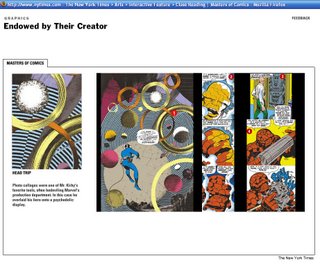 The Sunday Arts section of The New York Times often features a "Close Reading" of artwork currently on display in the city. Today, commemorating the opening of the traveling exhibition "Masters of American Comics," critic George Gene Gustines turns his critical eye toward the work of Jack Kirby - specifically, images from the landmark comic book Fantastic Four #51, cover-dated June, 1966. The column is reproduced as an interactive slideshow at the Times' website (link also currently available off this page).
The Sunday Arts section of The New York Times often features a "Close Reading" of artwork currently on display in the city. Today, commemorating the opening of the traveling exhibition "Masters of American Comics," critic George Gene Gustines turns his critical eye toward the work of Jack Kirby - specifically, images from the landmark comic book Fantastic Four #51, cover-dated June, 1966. The column is reproduced as an interactive slideshow at the Times' website (link also currently available off this page).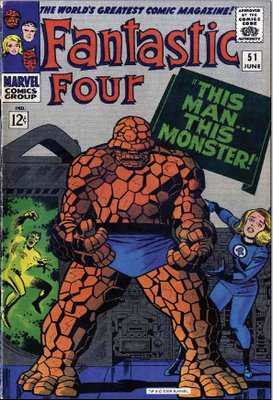 Gustines does a fine job of highlighting some of "King" Kirby's techniques and quirks in this brief overview, from the cartoonist's fondness for collage (never reproduced adequately in the original comic books) to his fantastic machinery designs. (If only he'd been able to cover some Kirby Krackle, as well!)
Gustines does a fine job of highlighting some of "King" Kirby's techniques and quirks in this brief overview, from the cartoonist's fondness for collage (never reproduced adequately in the original comic books) to his fantastic machinery designs. (If only he'd been able to cover some Kirby Krackle, as well!)Since you can read Gustines' comments at the link, I thought I'd take the opportunity to showcase a few more images from this story. First, for comparison, here's the collage example discussed in the article as it was originally published. When you compare it to the article's recolored version, you can see how 1960s-era comic book publication techniques did Kirby's photo collages no favors:
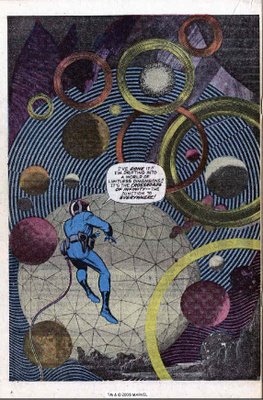 When it comes to machine design, the article's curiously labeled "Deep Closets" example can't compare to one of my favorite Kirby machines of all time, also conveniently featured in this issue - in fact, it's the machine Reed Richards (Mr. Fantastic) designs to allow him to travel to the "world of limitless dimensions" above:
When it comes to machine design, the article's curiously labeled "Deep Closets" example can't compare to one of my favorite Kirby machines of all time, also conveniently featured in this issue - in fact, it's the machine Reed Richards (Mr. Fantastic) designs to allow him to travel to the "world of limitless dimensions" above: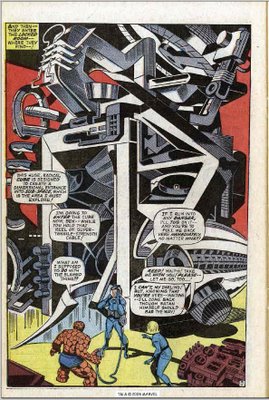 And finally, no discussion - however brief - of FF #51 should ignore the issue's iconic splash page, featuring a rain-soaked, silent portrait of Ben Grimm (The Thing). True, there's some of Stan Lee's trademark, over-the-top editorial matter plastered on the page, but in terms of the story itself, the image remains silent. The absence of dialogue or even narration renders the drawing a portrait of isolation - an isolation further enhanced by the nighttime rain shower which pelts the pavement and the morose Grimm alike.
And finally, no discussion - however brief - of FF #51 should ignore the issue's iconic splash page, featuring a rain-soaked, silent portrait of Ben Grimm (The Thing). True, there's some of Stan Lee's trademark, over-the-top editorial matter plastered on the page, but in terms of the story itself, the image remains silent. The absence of dialogue or even narration renders the drawing a portrait of isolation - an isolation further enhanced by the nighttime rain shower which pelts the pavement and the morose Grimm alike.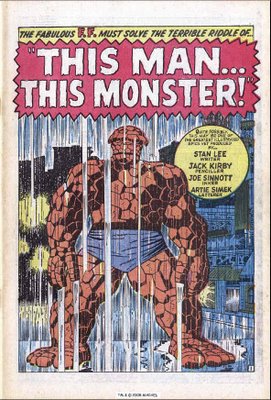 Lee rarely passed up the opportunity for snappy dialogue or "hipper-than-hip" narration, here he wisely allows Kirby's artwork to speak for itself. The somber tone perfectly prepares the reader for the story that follows, a superhero story in which "super powers" are used only twice: once when the impostor-Thing crushes a small metal canister, and once when Johnny Storm, the Human Torch, reluctantly sets his thumb ablaze to satisfy the curiosity of his gawking, fellow college students.
Lee rarely passed up the opportunity for snappy dialogue or "hipper-than-hip" narration, here he wisely allows Kirby's artwork to speak for itself. The somber tone perfectly prepares the reader for the story that follows, a superhero story in which "super powers" are used only twice: once when the impostor-Thing crushes a small metal canister, and once when Johnny Storm, the Human Torch, reluctantly sets his thumb ablaze to satisfy the curiosity of his gawking, fellow college students.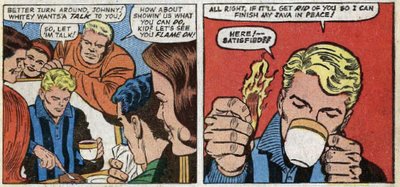 Here's hoping Gustines' article piques the curiosity of Times-readers who might otherwise have passed up the opportunity to visit this show. Masters of American Comics is on display until January 28th, 2007, with half at The Newark Museum (Masters Info) and half (including Kirby) at The Jewish Museum (Masters Info). The latter also is hosting a companion exhibit, Superheroes: Good and Evil in American Comics. Having missed the "Masters" exhibit's previous stops in Los Angeles and Milwaukee, I hope to visit these soon.
Here's hoping Gustines' article piques the curiosity of Times-readers who might otherwise have passed up the opportunity to visit this show. Masters of American Comics is on display until January 28th, 2007, with half at The Newark Museum (Masters Info) and half (including Kirby) at The Jewish Museum (Masters Info). The latter also is hosting a companion exhibit, Superheroes: Good and Evil in American Comics. Having missed the "Masters" exhibit's previous stops in Los Angeles and Milwaukee, I hope to visit these soon.Update: Wow, I can't believe I forgot to mention the monumental exhibit catalog (perhaps because I haven't got a copy yet, myself):
Masters of American Comics. Ed. John Carlin, Paul Karasik, and Brian Walker. Yale University Press, 2005. 328pp.Image credits: Top, the Times website; the rest are reproduced from the 44 Years of Fantastic Four
Labels: comic books, Fantastic Four, galleries, Kirby, museums, newspapers, superheroes


